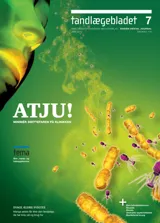Øre-, næse- og halsinfektionernes mikrobiologi
Den mikrobielle ætiologi til infektioner i de øvre luftveje omfatter følgende respirationsvejsvirus: rhino-, corna-, adeno-, respiratory syncytial virus, humant metapneumovirus, influenzavirus, parainfluenzavirus, cytomegalovirus, Epstein- Barr virus, herpes simplex virus og varicellazoster virus. De første syv af de nævnte virus giver anledning til forkølelse, pharyngitis og ”influenza-like illness” og kompliceres efter nogle dage ofte af tilstødende bakterieinfektion forårsaget af Streptococcus pneumoniae, Haemophilus influenzea (akapsulate, resistente for phenoxymethylpenicillin), Moraxella catarrhalis (næsten alle stammer producerer β-laktamase) og Streptococcus pyogenes gruppe A. Ved akut otitis media har man fundet, at man hos 1/3 kun kan påvise virus, 1/3 kun bakterier og 1/3 både virus og bakterier i sekretet i mellemøret. Desværre findes der ikke bed-side hurtigtest til at differentiere mellem ætiologierne, og klinisk skelnen kan være usikker, hvorfor mange anbefaler ”watchfull-waiting”, før antibiotikumbehandling startes eller undlades. Samme situation ses ved rhinosinusitis. For empirisk at dække de anførte fire bakteriearter anbefales amoxicillin med clavulansyre. De øvrigt nævnte virus kræver sjældent antiviral behandling hos immunkompetente patienter.
Microbiology of upper respiratory tract infections
The microbial etiology of upper respiratory tract infections comprise the following virus and bacteria: Rhino-, corna-, adeno-, respiratory syncytial virus, human metapneumovirus, influenzavirus, parainfluenzavirus, cytomegalovirus, Epstein-Barr virus, herpes simplex virus and varicella-zoster virus. The seven first mentioned virus cause common cold, pharyngitis and “influenzalike illness”. Frequently these viral infections are complicated after a few days of bacterial superinfections caused by Streptococcus pneumoniae, Haemophilus influenzea (acapsulate, resistant to phenoxymethylpenicillin), Moraxella catarrhalis (nearly all strains produce beta-lactamase) and Streptococcus pyogenes group A. Examinations of middle ear secretions from patients with acute otitis media show that 1/3 only contains virus, 1/3 only bacteria and 1/3 both virus and bacteria. Unfortunately no “bed-side” rapid tests exists which can differentiate between the different etiologies and clinical differentiation between viral and bacterial etiology is uncertain. Many clinicians, therefore, recommend “watchful waiting” before empiric antibiotic therapy is initiated or avoided. The same situation is found in rhinosinusitis. In order to cover the four bacterial species mentioned when empiric therapy is started, amoxycillin + clavulanic acid is recommended. The virus infections mentioned rarely require antiviral treatment except in immunocompromised patients.


